"Zhongyu" Is Chinese for "Finally": How it all happened
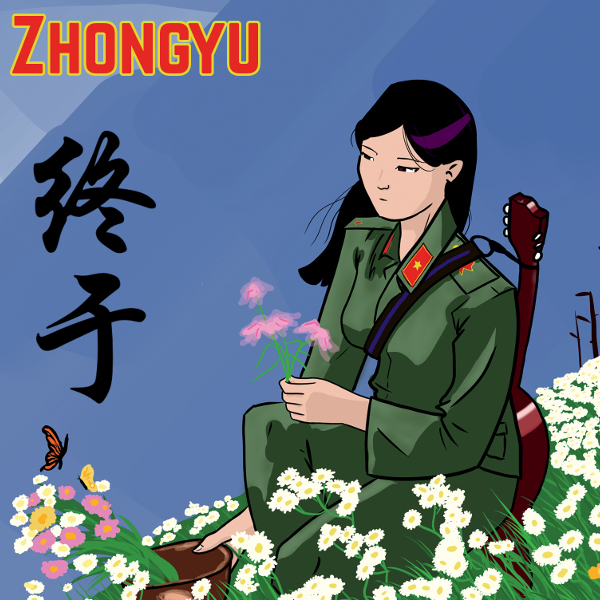 This is all from the Questions You Probably Weren't Going to Ask Department.
But I'm the kind of music nerd who likes to have information available,
and there may come a time when I don't remember this stuff, so this is my
off-site backup.
This is all from the Questions You Probably Weren't Going to Ask Department.
But I'm the kind of music nerd who likes to have information available,
and there may come a time when I don't remember this stuff, so this is my
off-site backup.
"Zhongyu" is Chinese for "Finally," and I can't think of a better name for this project. In my musical life, I've been through so many phases and detours, always somehow avoiding solid documentation, that the realization of this dream can only be greeted with a hearty "Finally!"
The album was unleashed on an unsuspecting world in the spring of 2016, but it was a long time in the making. It's been a long journey from programming some MIDI demos to Moonjune Records MJR078. And for anyone who's interested in the background and process of it all, this is for you. This material will not be on any test.
Before the Beginning
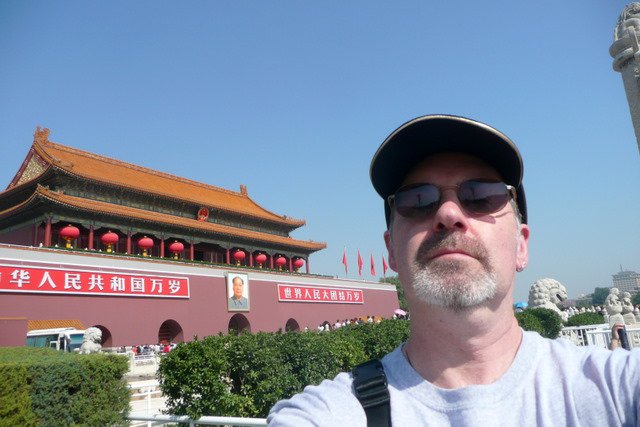 After kind of dropping out of playing for some time, the nearly three years I
lived in Beijing (2006-2009) revitalized my enthusiasm for music, going out to see live
performances nearly every week, and when I returned to Seattle I looked for
shows that would stimulate my brain. Almost immediately, I connected with
Rik Wright (with Zen Tornado at the time) and
Dennis Rea, whose band
Moraine encapsulated many of my own preferences in music: reaching beyond
standard structures and tonalities, incorporating aspects of jazz and modern
classical music into something vaguely resembling progressive rock, and
balancing head and heart in a way that felt like home.
After kind of dropping out of playing for some time, the nearly three years I
lived in Beijing (2006-2009) revitalized my enthusiasm for music, going out to see live
performances nearly every week, and when I returned to Seattle I looked for
shows that would stimulate my brain. Almost immediately, I connected with
Rik Wright (with Zen Tornado at the time) and
Dennis Rea, whose band
Moraine encapsulated many of my own preferences in music: reaching beyond
standard structures and tonalities, incorporating aspects of jazz and modern
classical music into something vaguely resembling progressive rock, and
balancing head and heart in a way that felt like home.
I started looking through my old demo tapes and scores to see what I had, and soon new ideas started coming to me. At first I thought of myself solely as a composer — I've never been a technical player on any instrument, but I had lots of ideas that others could bring to life.
A bit of serendipity came along late in 2010. I was shopping around for a bass guitar to use on my demos, and Kevin Millard, who plays NS Stick bass in Moraine, mentioned that he was looking to sell a Chapman Stick for a friend who was moving out of the country. I've always loved the Stick as an instrument, but never thought of playing it myself. The idea of taking up something new was very appealing, however, and turned out to be a real musical kick in the pants.
Oblique inquiries led me to believe Moraine would be open to trying outside compositions, and I came up with "In That Distant Place," an interpretation of a Chinese folk melody set against a 15/8 rhythmic pattern and an ambiguous tonality. They liked my home demo (with its programmed drums, violin, and sax parts), and it would eventually be recorded on their album Groundswell.
But I had lots of other ideas, and not all of them fit Moraine's style or instrumentation. I kept at it, and eventually had demos of enough music to make a good length album. I shared them with Dennis, who liked them enough to say to me, "What are you going to do with all of this?" Almost on the spot, I said, "How about you help me produce an album?" And Zhongyu was conceived.
The Beginning
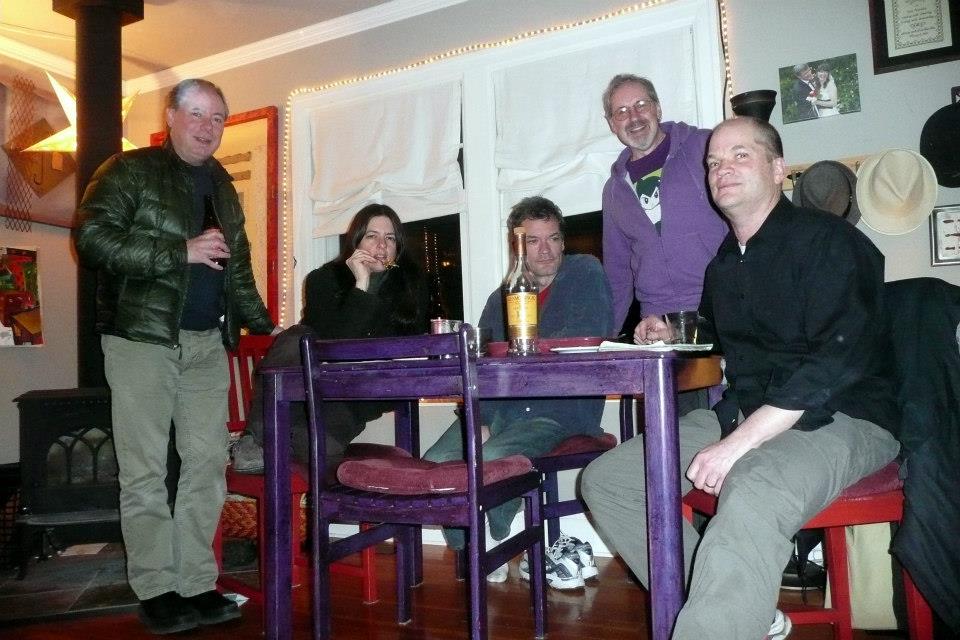 As it turned out, the demos featured Stick (mostly in the role of bass),
guitar (usually played on the Stick), drums, keyboards, and a variety
of melodic instruments, usually violin or flute. My idea was to find a
drummer, and then record the pieces as a studio project using different
musicians as needed, maybe featuring different guitarists on each track,
since I knew quite a few outstanding Seattle players. For the violin and
flute, it seemed natural to recruit Alicia and Jim DeJoie from Moraine,
and since Dennis was involved, we started out with him on guitar. Randy
Doak was the first drummer I thought of; I'd seen him play jazz, and
from conversations, I knew he was well-versed in progressive rock. And
he knew all of the others, having played with them in various Seattle
bands and projects over the years.
As it turned out, the demos featured Stick (mostly in the role of bass),
guitar (usually played on the Stick), drums, keyboards, and a variety
of melodic instruments, usually violin or flute. My idea was to find a
drummer, and then record the pieces as a studio project using different
musicians as needed, maybe featuring different guitarists on each track,
since I knew quite a few outstanding Seattle players. For the violin and
flute, it seemed natural to recruit Alicia and Jim DeJoie from Moraine,
and since Dennis was involved, we started out with him on guitar. Randy
Doak was the first drummer I thought of; I'd seen him play jazz, and
from conversations, I knew he was well-versed in progressive rock. And
he knew all of the others, having played with them in various Seattle
bands and projects over the years.
March 29, 2012 was the night of our first practice, and "Torture Chamber of Commerce" was the first piece we tackled; "Sleepwalking the Dog" was next. I picked those because they seemed relatively simple and didn't require me to cart the guzheng to rehearsal.
Is This a Real Band?
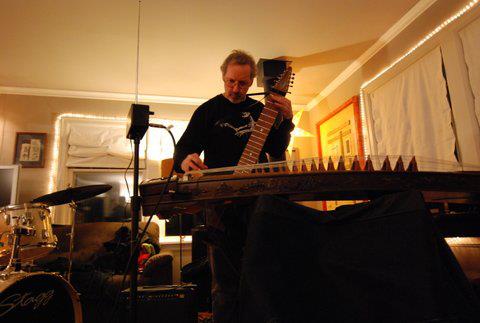 Although some of the pieces took a lot of rehearsal to get through,
it was apparent from very early on that this was going to work, and
before long I began thinking about playing live. All of the compositions
worked in rehearsal with just the five of us (basically just leaving off
the keyboard parts from the demos), and it would give us a chance to see
how audiences would react. We ended up playing live only two times,
including opening the first installment of the Seaprog festival in
2013. Given the other commitments of the musicians, it was apparent
that this would never be a regularly gigging band, however.
Although some of the pieces took a lot of rehearsal to get through,
it was apparent from very early on that this was going to work, and
before long I began thinking about playing live. All of the compositions
worked in rehearsal with just the five of us (basically just leaving off
the keyboard parts from the demos), and it would give us a chance to see
how audiences would react. We ended up playing live only two times,
including opening the first installment of the Seaprog festival in
2013. Given the other commitments of the musicians, it was apparent
that this would never be a regularly gigging band, however.
By the end of 2013, we had a full set of music that was long enough to make an album, though it wasn't exactly the same set as from the original demo. Check out the details for "Hydraulic Fracas" on the Tracks page regarding that. Dennis and I started thinking about the next phase of the project: getting the band into a studio. We talked a little with Jason Goessl, who has recorded some great music, but he didn't have enough space for a five-piece. Other names were tossed around, then we hit on the obvious choice: Steve Fisk. He had worked on some Moraine projects (mixing Metamorphic Rock and engineering Groundswell), and Dennis assured me that he would be sympathetic to the style. Contact was made, general agreement was reached, and finally he came to a rehearsal to check out the band in action.
A Visit to the Sound House
On a drizzly weekend in February of 2014, we decamped to Sound House Studios in North Seattle. Steve and his intern were already at work getting the studio ready, and Jack Endino was there helping out with microphones and so on. Dennis ended up using a vintage Fender amp that's been in the studio for a long time. It was apparently used by Kurt Cobain on one of Nirvana's albums. As the one whose instruments are most vulnerable to acoustic problems, Jim was put in the isolation booth. Since Alicia was exclusively playing electric violin, there was no need to get her out of the main room. Randy's drums (augmented by a few exotic cymbals borrowed from Don Berman) were set up on one side of the studio, and I took over another corner with the guzheng and my pedal board. The Stick was run directly into the board; for the guzheng we used both the piezo pickup and microphones (both above the strings and underneath).
The plan was to have solid, usable takes of all the tracks by the end of the day on Saturday, then use Sunday to overdub solos, fix any flubs that could be punched in, and maybe record some improvisations. The plan actually worked. We would do a couple of run-throughs of each piece, then gather in the control room to hear the playback and choose which take we liked best. The main criteria was that there was a good feel and any mistakes present were "fixable." There were no click tracks or pre-programmed parts, and we left off any solos that it made sense to overdub later.
If I remember correctly, the only whole piece left to do on Sunday morning was "Apple of My Mind's Eye 1," which we took care of first thing. Then we worked on the solos for the other tracks. I remember there being discussions about (for example) which take of a guitar solo was best, but for the most part we were all just amazed by how good everything sounded. I really wanted to get some improvisations recorded, and we got the chance on Sunday afternoon. I had a number of things in mind, and we didn't get to all of them. Typical of talented musicians, we were unsure whether any of the improvised material would stand up to scrutiny, but I was hopeful. From the beginning, I've wanted Zhongyu to balance composition and improvisation. None of these improvs was totally free in the conventional sense: I set up the parameters, be they instrumentation, mood, tonality, or whether there should be a tempo. With me starting each of them, either on guzheng or Stick, they took my cues amazingly well.
The Long March
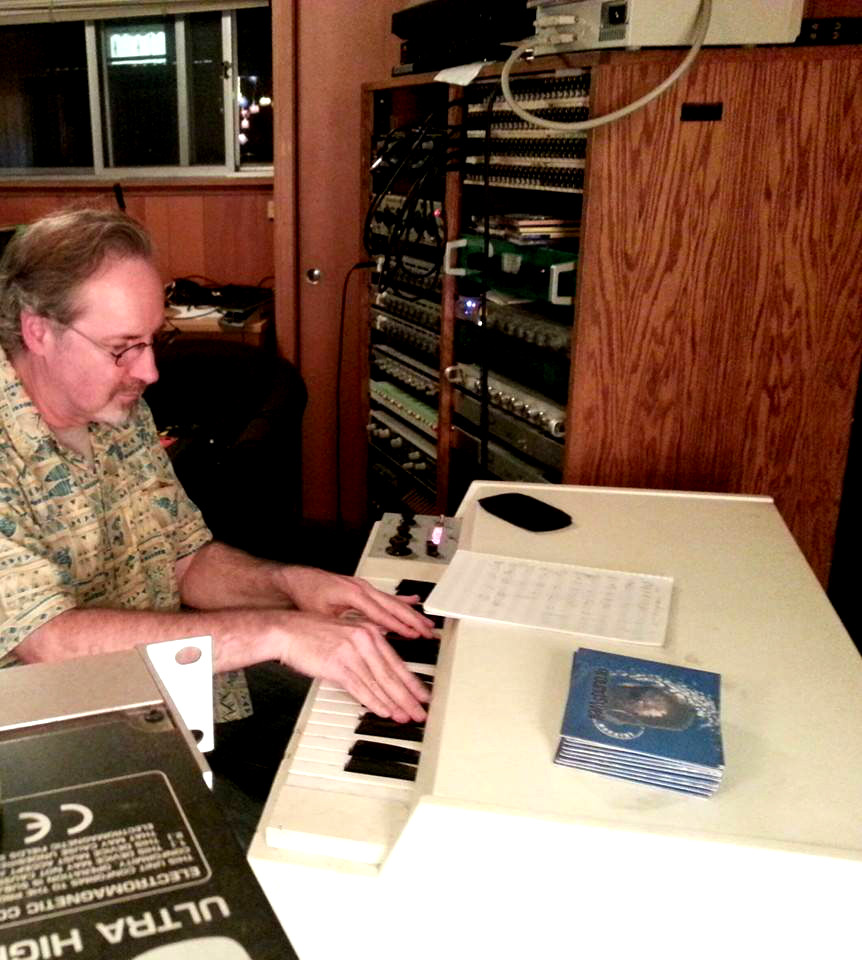 At some time after our weekend in the studio, Dennis, Steve, and I
started meeting more or less weekly, tackling one track each night.
For a while, Dennis was off on tour in Siberia, so Steve and I worked
through some tracks without him. I think it was late summer when I
took the guzheng to Steve’s place to record "Apple of My Mind’s Eye 2."
Other parts were added at Steve's as well: the extra Stick parts on
"Torture Chamber," the Mellotron on "Sleepwalking the Dog," and Daniel
Barry's trumpet part for "MBBL." What with scheduling difficulties,
it wasn't until October or so that we had our final mixes.
At some time after our weekend in the studio, Dennis, Steve, and I
started meeting more or less weekly, tackling one track each night.
For a while, Dennis was off on tour in Siberia, so Steve and I worked
through some tracks without him. I think it was late summer when I
took the guzheng to Steve’s place to record "Apple of My Mind’s Eye 2."
Other parts were added at Steve's as well: the extra Stick parts on
"Torture Chamber," the Mellotron on "Sleepwalking the Dog," and Daniel
Barry's trumpet part for "MBBL." What with scheduling difficulties,
it wasn't until October or so that we had our final mixes.
We sent the final mixes to Leonardo Pavkovic of Moonjune Records, and he liked them enough to give a conditional agreement to release the final product on the label, though his release schedule was already filled up until roughly the middle of 2016. I also got an agreement from my nephew Tristan Olson to do the cover art, when the time came for that. See the About the Cover section for more details.
Obviously the next step was getting the tracks mastered, but as it turned out, I was laid off from my day job in October, and wasn't in a position to lay out the money for that expense. After I was gainfully re-employed, we hooked up with Steve Turnidge to do the mastering. He worked out all of the individual tracks, the Dennis and I went to his house for the final sequencing. This last step tightened things up immensely, working out all the transitions from track to track. I was amazed that he was able to crossfade between tracks in ways that sounded good either in sequence or when pulled out individually. By this time, we were somehow approaching the end of 2015.
In the first part of 2016, things started moving more quickly. Leonardo told us he was aiming for a mid-May release, so I contacted Tristan and got him going on the cover art. I really liked his drawing style from his web comics, and wanted him to interpret a couple of old Chinese propaganda posters in his style. I mocked something up and gave it to him, and he came up with the striking illustrations for the front and back covers.
What's Next
Or maybe that should be "What's next?"
I was pretty exhausted after all the effort and expense that went into recording Zhongyu, but really loved playing music regularly. But it was pretty apparent that Zhongyu could never be a regular gigging band. All of the players aside from me were involved in multiple other projects, so simply coordinating rehearsal and performance schedules would be a nightmare.
Over the course of Zhongyu's development, Randy and I had worked together to tighten up some of the rhythm parts, and both of us felt that our Stick / drums combo worked pretty well. We even worked up a piece I called "11.9% ABV" and played it on stage once. It honestly didn't go very well, but the feeling was that we had the potential for something interesting.
Then I started thinking about Seaprog's second year, and got the idea to work something out. The duo with Randy was too risky, especially relying on coordination of electronics, so I asked Jim to join and make a trio. Super Z Attack Team was born.
Bearing in mind the uncomfortable (and risky) exposure of the limited instrumentation, and wanting to bring something different and unexpected into the music, I wanted to bring in samples and electronic sounds. For the Seaprog show, I worked up a library of source material that included historical recordings of John F. Kennedy, Winston Churchill, Maya Angelou, and others, along with analog synthesizer pieces I recorded back in the 80s. I used Giada on an old laptop running Ubuntu to trigger the samples.
So this became the defining feature of Super Z Attack Team: rowdy odd-meter rock combined with jazzy improvisation and electronic elements. Given the sound of the name, we adopted a kind of anime science-fictional imagery, and have occasionally performed with projections of randomly selected animation.
About the Cover
While I lived in China, I saw a lot of old propaganda art. It's not that you still see the posters up in public places — seems like it's more for tourists' benefit anymore. At some point I came across one that really stuck with me.
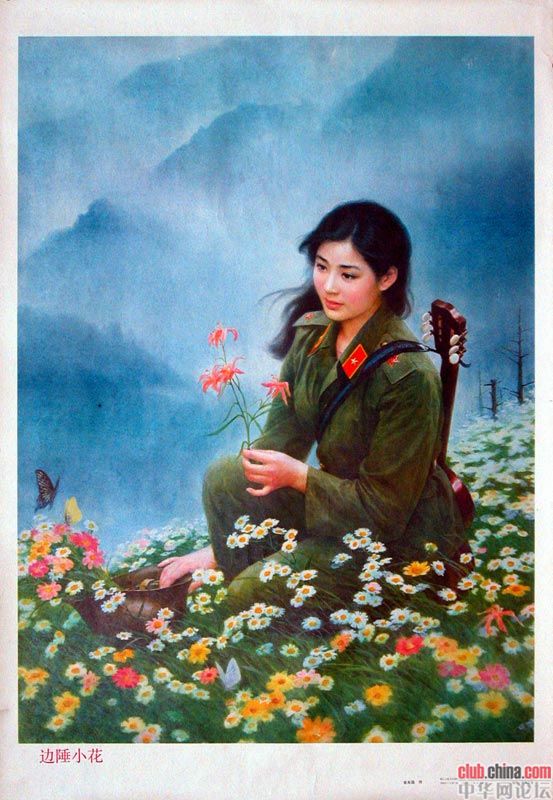 I don't know much about it, aside from the title Bianchui xiao hua (Little Flower
of the Border) and that it probably dates from the 80s.
I don't know much about it, aside from the title Bianchui xiao hua (Little Flower
of the Border) and that it probably dates from the 80s.
When it came time to come up with cover art for the Zhongyu album, I immediately thought of this striking image. But I didn't want to simply appropriate this artist's work. I thought of my nephew Tristan Olson, who for years published web comics, and whose style I always liked. How about combining these two things, the imagery of the Little Flower of the Border with Tristan's style? A little touch of manga mashed up with Maoist propaganda — in my mind, I figured it would work, and luckily he agreed to give it a go.
I couldn't be happier with the result. This image really seems to catch people's attention... which is exactly what an album cover should do.
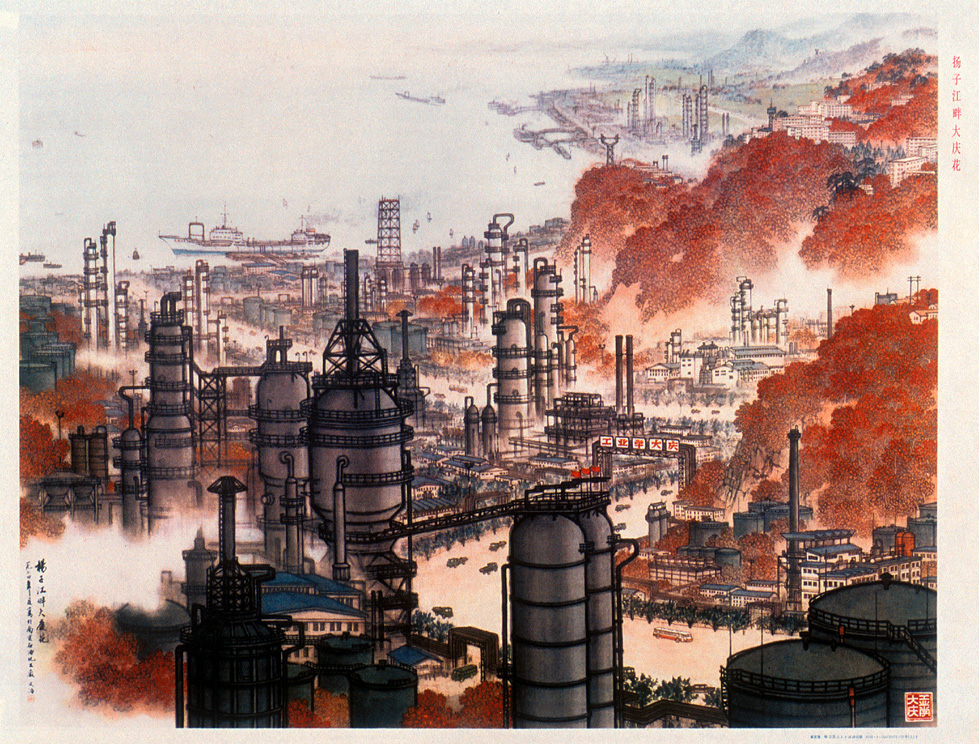 For the back cover, I went for another old propaganda poster, one that
embodies the contrasts of the music when compared with the idyllic Little
Flower. This one most likely dates from the 70s, and I'm sure it's meant to
instill pride in the industrial modernization that China was going through at
the time. But to a modern eye, it's basically a hellish mire of pollution and
poison. I asked Tristan to replace one of the factory towers with a spaceship,
and again he came through with flying colors.
For the back cover, I went for another old propaganda poster, one that
embodies the contrasts of the music when compared with the idyllic Little
Flower. This one most likely dates from the 70s, and I'm sure it's meant to
instill pride in the industrial modernization that China was going through at
the time. But to a modern eye, it's basically a hellish mire of pollution and
poison. I asked Tristan to replace one of the factory towers with a spaceship,
and again he came through with flying colors.